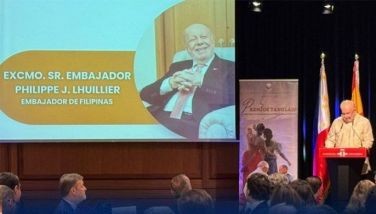What Sid said...

February 5, 2006 | 12:00am
Was that he doesn’t trust the spoken word, that what concerns him is how the poem appears on the printed page. It’s not that he’s against performance poetry, it’s just that the poem’s content must not be upstaged by how it is performed.
Sid is Sid Gomez Hildawa, 43, visual artist-slash-poet-slash-architect, one of the rare ones with equal facility in writing and drawing, not to mention making full use of empty spaces. But it’s not that simple; it never was.
Offhand one could think of other artist-writers–or is it writer-artists? –Cesare Syjuco, HR Ocampo, the Ayalas of Davao. Just last December Sid launched his first collection of poems under the NCCA-sponsored Ubod series, "Regarding Space", marking his more or less formal breakthrough in literary circles.
Not that he hasn’t been around lately, since he has been joining contests like the Palanca–barely missing a place in the top 3 a couple of years ago–and is a founding member of the literary group Alon, composed mostly of De La Salle University graduate students whose first poetry anthology notched a national book award last year.
"That’s my cross. I have to work twice as hard to be accepted in the writing community, in the visual arts community, and among architects. Because they might not think I’m serious, like I have a mistress," Sid says on the first Wednesday of the still young year, in a watering hole off Remedios Circle in Malate.
He may be a relative newcomer to the literary scene, but Sid is a certified veteran when it comes to architecture and the visual arts. He won the 13 Artists Award of the CCP in 1992, and is an architect by profession. He was been with the CCP visual arts division for the past nine years.
"It was a weird mix," he now says of his ’92 batch, because they weren’t really of the same generation: others who won that year include Imelda Cajipe Endaya, Brenda Fajardo, and Jean Marie Syjuco, with whom he had curated the show of Jean Marie’s husband Cesare in early 2005.
Upon graduating from architecture school and passing the board, one of Sid’s first jobs was designing the interiors of the RJ bistros.
Architectural elements cannot but be manifest in his poetry: "When I enter a room, I note the height of the ceiling, where the posts are, and the general layout of tables, how they affect space."
He says that a number of accomplished artists are in fact architects by training: Edades, Chabet, Orlina.
When asked about his reaction on Cirilo Bautista’s once controversial statement that "all poets can paint, but not all painters can write poetry," Sid laughs and says of his mentor: "Obviously, he was biased for writers."
Cirilo, Sid’s teacher at DLSU graduate school, had published Sid’s first poem in Panorama magazine, "Window to the Wind" in the ’90s. We suspect this was shortly after Hildawa and Mike Maniquiz presided over the groundbreaking three issues of the alternative NG interactive literary magazine.
Of his three disciplines, Sid says it is only poetry where he cannot delegate the work, "and in that sense, it is very personal."
He adds: "But my visual orientation is carried through to my poetry. I want my poems to be read, not necessarily recited."
And unlike the more celebrated performance poets, he doesn’t feel the need to memorize his poems.
"What’s important is how the poem looks on the page. I do not trust the spoken word. Which is not to say I’m against it. It’s just that sometimes the performance upstages the content of the poem. My poems are more the quiet type, they speak to one reader at a time."
Part of this mistrust, Sid admits, is due to his own hearing impairment. The poet-artist-architect is 30 percent deaf.
"So there’s a chance during a reading that maybe a couple of listeners would have hearing impairment," he says, and what he does is provide members of the audience with hard copies of the poem he is to read.
Again not so much to give allowance to variances of phonetics as a respect for the habit of reading. "Even in movies where we already understand the dialogue, if there are subtitles we still read them," he says.
In the visual arts, he has been something of a trailblazer. Apart from NG, whose avant-garde concept he helped design, he has also worked with installations of hollow blocks as well Xerox art, specifically the exhibit "The Xerox of Her Smile" when colored photocopying machinery were a novelty.
In the year 2000 he was selected as one of the country’s representatives to the 7th Havana Biennal, for his installation "Dream Houses of People Who Live With Their Parents." Found interviews and candlewax conspire for this village-like 3-D blueprint, details of which can be gleaned on the Internet.
For a week he was in Havana with other Philippine delegates to the biennial, including Junyee, Impy Pilapil, Bogey Tence Ruiz, and filmmaker Aureaus Solito, whose digital feature was shown at one venue in a seeming endless loop.
"It was like Intramuros," he says of the Cuba libre experience, and whose city streets he had written about in his poem "Havana Away From Home": Obispo, Mercaderes, Malecon.
"But after a few days you see through the tourism hardsell. They make a big to-do about the cafe where Hemingway hung out, and then in the evenings there’s street dancing at every corner." And maybe, a swirl of a Santana-like guitar stalking the restless soul under a full moon.
Presently Sid is working on his PhD in creative writing at La Salle, where his proposed thesis will explore the possibilities of hypertext poetry.
"The challenge is not to be overwhelmed by the technology... the poetry should not suffer," he says of this latest project where the reading of a poem would take the reader to various links, planes and inter-texts until the poem or, perchance, the reading is completed, whichever comes first.
The emotion for him retains primacy in his poetry, and for which he "may or may not be old-fashioned."
Among foreign poets he has read Billy Collins, Charles Simic, but a favorite is Philip Levine, who Sid says balances the emotional aspect of the poem with an even-handed calmness that obliges the reader to keep reading.
Of course, closer to home Cirilo Bautista has been friend, mentor, and adviser too to the Alon group of poets and writers.
It was Cirilo who gave Alon its name, Sid says. "We were on our way to Baguio for a BN Santos writing workshop, when Cirilo asked us what does the sea say to the sky? Nothing, it just waves."
It’s a different satisfaction he gets when he finishes a poem, which he says takes longer to make. "It takes several drafts over a month or two, and I consult with the Alon group to see my blind spots.
"Part of the juggling act is not to compare. As they say, love the one you’re with."
Alon’s next anthology, he says, will focus on fiction.
From May to September this year he will be off to the US for an Asian Cultural Council grant that will take him to the museums, art galleries and libraries of New York, Washington, Chicago.
It will also give him time to renew old friendships with former Makati neighbor Eric Gamalinda, Luisa Igloria, Eileen Tabios and ex-partner-in-crime Maniquiz. Not a few of whom are keen on linking up for the forthcoming Chromatext show of poem-paintings–or is it painting-poems–at the CCP in January 2007 which Sid will most likely curate.
Sid is Sid Gomez Hildawa, 43, visual artist-slash-poet-slash-architect, one of the rare ones with equal facility in writing and drawing, not to mention making full use of empty spaces. But it’s not that simple; it never was.
Offhand one could think of other artist-writers–or is it writer-artists? –Cesare Syjuco, HR Ocampo, the Ayalas of Davao. Just last December Sid launched his first collection of poems under the NCCA-sponsored Ubod series, "Regarding Space", marking his more or less formal breakthrough in literary circles.
Not that he hasn’t been around lately, since he has been joining contests like the Palanca–barely missing a place in the top 3 a couple of years ago–and is a founding member of the literary group Alon, composed mostly of De La Salle University graduate students whose first poetry anthology notched a national book award last year.
"That’s my cross. I have to work twice as hard to be accepted in the writing community, in the visual arts community, and among architects. Because they might not think I’m serious, like I have a mistress," Sid says on the first Wednesday of the still young year, in a watering hole off Remedios Circle in Malate.
He may be a relative newcomer to the literary scene, but Sid is a certified veteran when it comes to architecture and the visual arts. He won the 13 Artists Award of the CCP in 1992, and is an architect by profession. He was been with the CCP visual arts division for the past nine years.
"It was a weird mix," he now says of his ’92 batch, because they weren’t really of the same generation: others who won that year include Imelda Cajipe Endaya, Brenda Fajardo, and Jean Marie Syjuco, with whom he had curated the show of Jean Marie’s husband Cesare in early 2005.
Upon graduating from architecture school and passing the board, one of Sid’s first jobs was designing the interiors of the RJ bistros.
Architectural elements cannot but be manifest in his poetry: "When I enter a room, I note the height of the ceiling, where the posts are, and the general layout of tables, how they affect space."
He says that a number of accomplished artists are in fact architects by training: Edades, Chabet, Orlina.
When asked about his reaction on Cirilo Bautista’s once controversial statement that "all poets can paint, but not all painters can write poetry," Sid laughs and says of his mentor: "Obviously, he was biased for writers."
Cirilo, Sid’s teacher at DLSU graduate school, had published Sid’s first poem in Panorama magazine, "Window to the Wind" in the ’90s. We suspect this was shortly after Hildawa and Mike Maniquiz presided over the groundbreaking three issues of the alternative NG interactive literary magazine.
Of his three disciplines, Sid says it is only poetry where he cannot delegate the work, "and in that sense, it is very personal."
He adds: "But my visual orientation is carried through to my poetry. I want my poems to be read, not necessarily recited."
And unlike the more celebrated performance poets, he doesn’t feel the need to memorize his poems.
"What’s important is how the poem looks on the page. I do not trust the spoken word. Which is not to say I’m against it. It’s just that sometimes the performance upstages the content of the poem. My poems are more the quiet type, they speak to one reader at a time."
Part of this mistrust, Sid admits, is due to his own hearing impairment. The poet-artist-architect is 30 percent deaf.
"So there’s a chance during a reading that maybe a couple of listeners would have hearing impairment," he says, and what he does is provide members of the audience with hard copies of the poem he is to read.
Again not so much to give allowance to variances of phonetics as a respect for the habit of reading. "Even in movies where we already understand the dialogue, if there are subtitles we still read them," he says.
In the visual arts, he has been something of a trailblazer. Apart from NG, whose avant-garde concept he helped design, he has also worked with installations of hollow blocks as well Xerox art, specifically the exhibit "The Xerox of Her Smile" when colored photocopying machinery were a novelty.
In the year 2000 he was selected as one of the country’s representatives to the 7th Havana Biennal, for his installation "Dream Houses of People Who Live With Their Parents." Found interviews and candlewax conspire for this village-like 3-D blueprint, details of which can be gleaned on the Internet.
For a week he was in Havana with other Philippine delegates to the biennial, including Junyee, Impy Pilapil, Bogey Tence Ruiz, and filmmaker Aureaus Solito, whose digital feature was shown at one venue in a seeming endless loop.
"It was like Intramuros," he says of the Cuba libre experience, and whose city streets he had written about in his poem "Havana Away From Home": Obispo, Mercaderes, Malecon.
"But after a few days you see through the tourism hardsell. They make a big to-do about the cafe where Hemingway hung out, and then in the evenings there’s street dancing at every corner." And maybe, a swirl of a Santana-like guitar stalking the restless soul under a full moon.
Presently Sid is working on his PhD in creative writing at La Salle, where his proposed thesis will explore the possibilities of hypertext poetry.
"The challenge is not to be overwhelmed by the technology... the poetry should not suffer," he says of this latest project where the reading of a poem would take the reader to various links, planes and inter-texts until the poem or, perchance, the reading is completed, whichever comes first.
The emotion for him retains primacy in his poetry, and for which he "may or may not be old-fashioned."
Among foreign poets he has read Billy Collins, Charles Simic, but a favorite is Philip Levine, who Sid says balances the emotional aspect of the poem with an even-handed calmness that obliges the reader to keep reading.
Of course, closer to home Cirilo Bautista has been friend, mentor, and adviser too to the Alon group of poets and writers.
It was Cirilo who gave Alon its name, Sid says. "We were on our way to Baguio for a BN Santos writing workshop, when Cirilo asked us what does the sea say to the sky? Nothing, it just waves."
It’s a different satisfaction he gets when he finishes a poem, which he says takes longer to make. "It takes several drafts over a month or two, and I consult with the Alon group to see my blind spots.
"Part of the juggling act is not to compare. As they say, love the one you’re with."
Alon’s next anthology, he says, will focus on fiction.
From May to September this year he will be off to the US for an Asian Cultural Council grant that will take him to the museums, art galleries and libraries of New York, Washington, Chicago.
It will also give him time to renew old friendships with former Makati neighbor Eric Gamalinda, Luisa Igloria, Eileen Tabios and ex-partner-in-crime Maniquiz. Not a few of whom are keen on linking up for the forthcoming Chromatext show of poem-paintings–or is it painting-poems–at the CCP in January 2007 which Sid will most likely curate.
BrandSpace Articles
<
>
- Latest
- Trending
Trending
Latest
Trending
Latest
Recommended


















